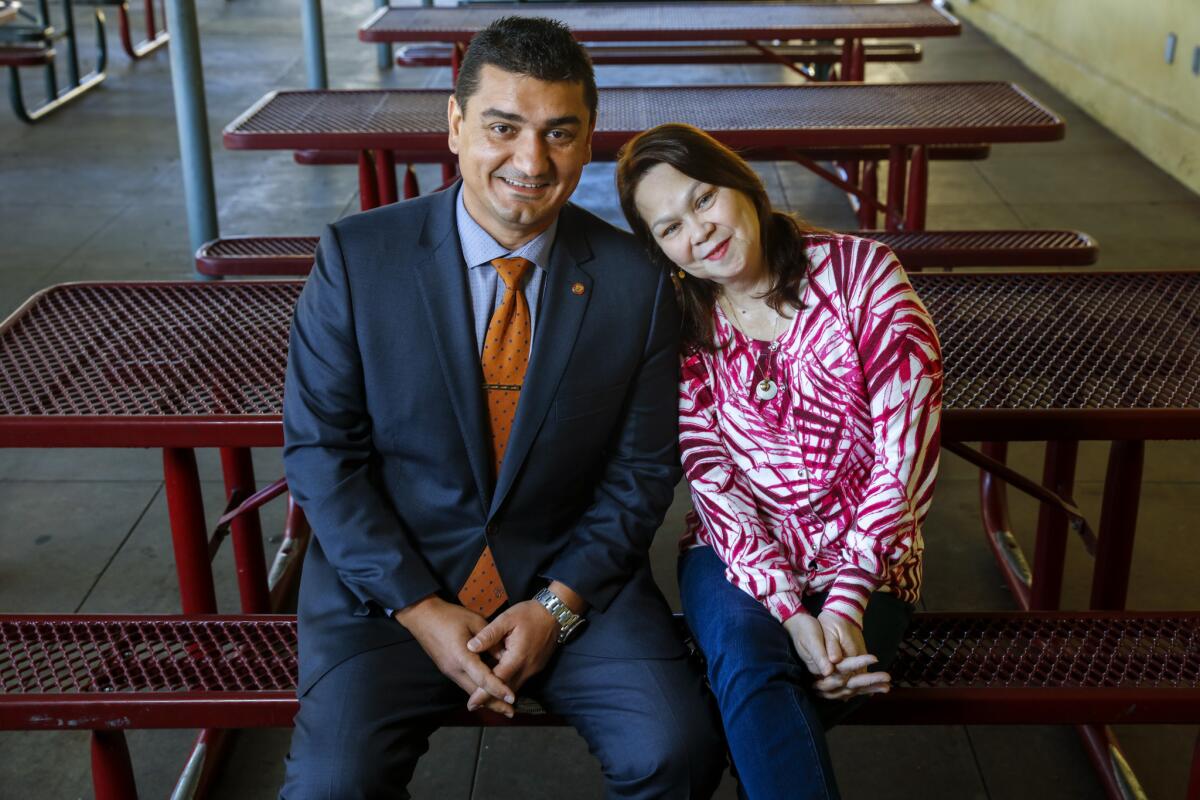Is your school CPR trained? She’s alive because this principal is

Elizabeth Vallejo was having a heart attack.
It was Leap Day, and Vallejo, who prepares food for students, had finished her cafeteria shift at Hesby Oaks Leadership Charter. Around 1:30 p.m., she walked over to her manager's office to sign out, turned around to leave the room and fell to the ground.
Lucky for Vallejo, the school’s principal, Movses Tarakhchyan, used to be a lifeguard. On top of that, he required that the whole school receive CPR training over the summer, one of his first moves as the new principal.
Tarakhchyan got a radio call from his staff: There was an injury, and they needed him.
He ran to the cafeteria, he recalled, thinking it could be a student hurt in a nearby PE class.
Instead, he found Vallejo on her back in the manager’s office, and it looked like her mouth was slightly foaming. He thought she might be having a seizure, so he turned her on her side. Then he checked for a pulse but found none.
The school gets a nurse only twice a week, and Feb. 29 was not one of those days. So one employee called 911 while another ran to retrieve the automatic electronic defibrillator machine from the nurse’s office while Tarakhchyan began performing manual CPR, pushing Vallejo’s chest and checking for her pulse.
“It’s not like in the movies where after two, three pumps somebody wakes up,” he said. He thinks he performed CPR for a full five minutes, but it’s hard to say because it felt like time stopped, he said.
It’s the defibrillator that Tarakhchyan credits with saving Vallejo’s life.
There are 411 such machines distributed to over 780 schools in the Los Angeles Unified district. All schools built after 2014 have one, L.A. Unified spokesman Samuel Gilstrap said. The district does not have an estimate of how many schools have received CPR training. When schools request training, though, the districts helps.
When Tarakhchyan used the machine from Hesby Oaks, it couldn’t find a pulse, instead speaking out loud and telling him to shock Vallejo. He did, but three minutes later, the machine repeated, “No pulse found. Shock advised.” Tarakhchyan shocked her again.
Throughout the process, the principal says he flashed back to the last time he tried to save a life. About four years ago, Tarakhchyan’s father died of a heart attack in the backyard. Tarakhchyan had tried CPR then, but it didn’t work. His family later found out the heart attack was so bad, the principal’s father likely died before he hit the ground.
------------
FOR THE RECORD
March 31, 10:26 a.m.: An earlier version of this article stated that Movses Tarakhchyan’s father died of a heart attack about four months ago. He died about four years ago.
------------
Tarakhchyan didn’t think this time would be any different. Three minutes passed. The machine spoke again.
“Pulse found.”
Finally, the ambulance arrived.
The emergency medical technicians disconnected the machine and congratulated Tarakhchyan for keeping his employee alive.
Manuel Vallejo walked out of his storeroom shift at 3 p.m. expecting to see his wife, who usually picks him up. Instead he saw his 19-year-old son. He had no cellphone service at work, so the school had called his older son in Northern California. All that was known was that Elizabeth Vallejo was in the hospital, that she'd had a heart attack.
Father and son rushed to Providence Tarzana Medical Center, where Elizabeth was undergoing angioplasty, a surgery to unblock her arteries.
While the two waited, Elizabeth’s manager told Manuel Vallejo what had happened. It felt like a punch in the gut, he said, as he wondered what would have happened if the heart attack had happened a few minutes later, while she was in the car, or when the principal wasn’t there, or didn’t know how to perform CPR.
The doctor told Manuel that his wife was lucky to be alive. The cardiologist who treated Elizabeth, Dr. Daniel Manavi, confirmed that Tarakhchyan’s CPR saved Elizabeth.
Manuel met his wife in the Philippines, and the two moved to California in the 1980s. Here, they raised two sons, one of whom wants to be a nurse. For the two days when her health status was unclear, he slept for only about 45 minutes.
Elizabeth Vallejo doesn’t remember anything about the heart attack, other than waking up in the hospital. But talking about it weeks later, she cries.
“This is my second life,” she said over the phone, in between tears. “The principal, he didn’t give up.”
Sonali Kohli at [email protected] or on Twitter @Sonali_Kohli.
Sign up for Essential California
The most important California stories and recommendations in your inbox every morning.
You may occasionally receive promotional content from the Los Angeles Times.








